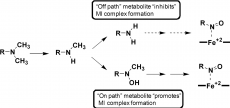

Microbial Methylated Amine Metabolism has Implications for health and Disease
Abstract
Here we discuss the links between microbial methylamine metabolism and its links to increased risk of disease. There is evidence to support a strong relationship between dietary choice and composition of gut microbiota. Disruptions of choline metabolism has associations with non-alcoholic fatty liver disease and impaired glucose homeostasis. Such evidence suggests that Western lifestyle choices are major factors that should be targets for future research.
Introduction
The human gut microbiome consists of a complex community of more than 1000 bacterial species. To differentiate between different species, metabolic characteristics can be understood through studying microbes that use various metabolic strategies. These metabolic properties contribute to the control of ecological niches. Microbial metabolism is the ways in which microbes acquire the required nutrients and energy for survival and reproduction. The human gut microbiome is highly necessary as it plays a key role in disease and our health. Compositions of gut microbiota vary based on various factors such as diet, medicines, disease, mode of delivery at birth, infant feeding methods and host genetics. Diet is a leading factor. Methylamines are important organic compounds that can be generated anaerobically through specific precursors. They are a group of metabolites found in the human gut and have been studied as uremic toxins.
Methylamine synthesis occurs through amine catabolism using precursors such as choline, carnitine, and trimethylamine oxide (TMAO). Choline is ingested in foods such as red meat, egg yolk, fresh milk, yoghurt and fish. In the intestinal tract, this is where most trimethylamine is produced. Tissue levels of methylamines increase in certain pathological environments, such as diabetes.
Microbes transform dietary precursors, like choline, into methylated amines (mono-methylamine, dimethylamine and trimethylamine). However, this has led to several human disorders, such as liver disease, insulin resistance and cardiovascular disease. Methylamines are thought to be uremic toxins. There is evidence to support dimethylamine and trimethylamine in sufferers of impaired renal function. Impaired renal function leads to increasing levels of TMAO and choline. Gut microbiota, called methylotrophs, firstly convert choline into TMA. Methylotrophs are able to use a single carbon compound, lacking in carbon-carbon bonds, as an energy source. Formaldehyde and formate are key intermediates for methylated amine metabolism as they determine whether carbon is oxidised into carbon dioxide or made into cell carbon. This assimilation of carbon from formaldehyde occurs through the ribulose monophosphate cycle. Formate uses the serine cycle. Oxidation of methylated amine can occur through the direct MMA-oxidation pathway or in an indirect pathway involving the oxidation of MMA to 5,10-methylenetetrahydrofolate. For the direct pathway, MMA oxidase is responsible in Gram positive bacteria, MMA dehydrogenase in Gram-negative methylotrophs.
image-http://dmd.aspetjournals.org/content/38/6/963

0 Comment:
Be the first one to comment on this article.